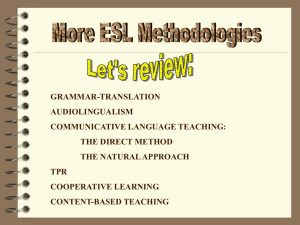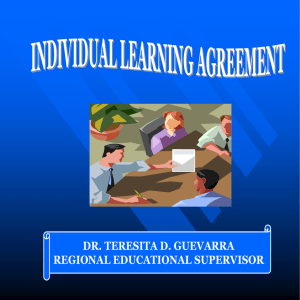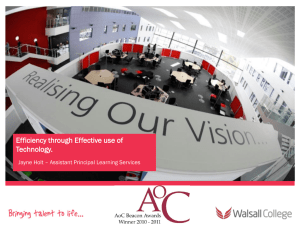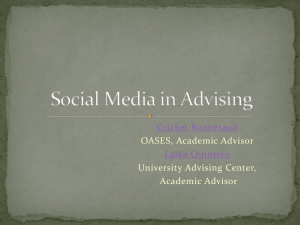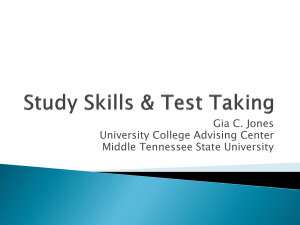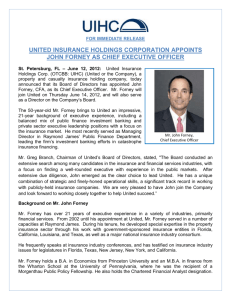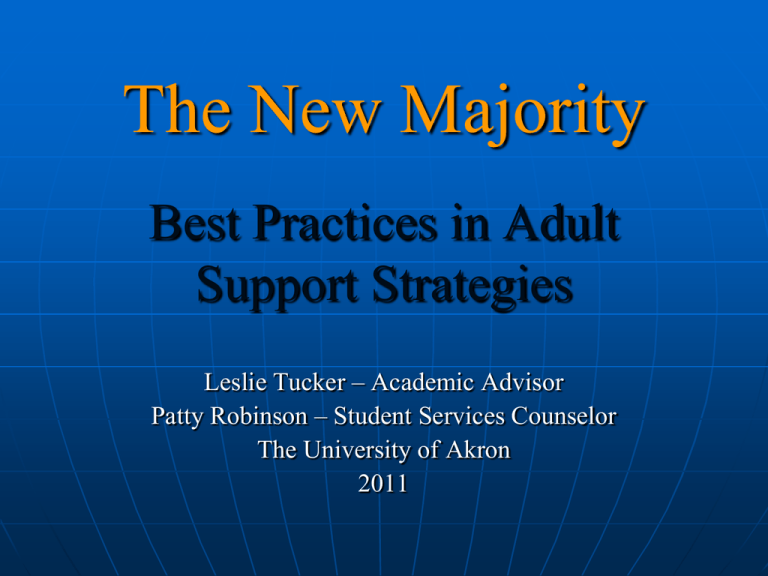
The New Majority
Best Practices in Adult
Support Strategies
Leslie Tucker – Academic Advisor
Patty Robinson – Student Services Counselor
The University of Akron
2011
The New Majority
“As (these) trends
continue, higher
education must be
prepared to understand
this cohort of students
and provide the
academic support
services that they need
to succeed in reaching
educational, career,
and personal goals.”
Bland, 2004
The New Majority
The Adult Learner
What are our intended learning outcomes?
•Professionals participating in this session should:
Understand why adult learners are becoming the new
majority.
Develop a working definition of the adult learner.
Recognize significant characteristics of this population.
Apply adult developmental theory to the higher education
transition.
Be aware of strategies to support adult learners.
Identify a focus area for improvement within their
individual institution.
The New Majority
Why focus on the adult learner?
• Ohio’s Third Report on the Condition of Higher Education:
Student Centered Initiative is to have 230,000 more
students by the year 2017.
Ohio Board of Regents, 2010
• The University of Akron’s Ten Year Strategic Plan focuses
on increased enrollment and completion rates by
accommodating adult learners.
The University of Akron, 2011
• The Council for Advancement of Standards in Higher
Education (CAS) has developed guidelines for effective
Adult Learner programs and services to ensure student
success.
Hardin, 2009
The New Majority
Why focus on the adult learner?
• Research in the area of student success concludes a high
importance of strong relationships between students and
faculty and staff.
NACADA, 2010
• 6.8 million people entering higher education institutions are
twenty-five years old and over.
• The GI Bill.
• Completion rates vary from 15% to 36% among adult
learners.
Ritt, 2009
The New Majority
Who is the adult learner?
• Adult students are often referred to as nontraditional
students; yet not all nontraditional students are adult
students.
• The term nontraditional can include traditional-aged
students who share common characteristics with their adult
counterparts.
• Many characteristics put them “at-risk” of obtaining
academic success.
Brock, 2010
The New Majority
What “at-risk” characteristics do adult learners bring
with them to college?
•
•
•
•
•
•
Enrolled part time
Work full time
Financially independent
Financially responsible for others
Family responsibilities
Academic deficiencies
• Delayed enrollment
DiMaria, 2009
The New Majority
What barriers do adult learners face as they enter
higher education?
• Institutional Barriers
Proximity to home and work
Course availability
Extended office hours
Accurate academic advising
• Situational Barriers
Role conflict
Time management
Family and work problems
Finances
The New Majority
What barriers do adult learners face as they enter
higher education?
• Psychological Barriers
Coping skills
Lack of self-confidence and poor self image
Anxiety about schooling based on prior experience
Negative beliefs or expectations about outcomes
• Educational Barriers
Under prepared academically
Developmental coursework
Brock, 2010
The New Majority
What does adult developmental theory say?
• Schlossberg’s Transition Theory (1981;1995) was
developed to help professionals understand and offer
interventions for adults in transition.
What is a transition?
• Change in roles, relationships, or routines
What coping mechanisms can the student draw on?
• Situation, self, supports, and strategies
What techniques can the academic advisor apply?
• Ask questions and supplement answers
Evans, Forney, & Guido-DeBrito, 1998
Evans, Forney, Guido, Patton, & Renn, 2010
The New Majority
Research on adult support systems and student
success?
• State of Ohio support strategies:
Lorain and Owens Community College
“Open Doors” Demonstration
Sample Size: 2,100
Largely non-traditional students
Regular, intensive, and personalized advising
Advisor to student ratio 1 to 160
Brock, 2010
The New Majority
Research on adult support systems and student
success?
• Appreciative Advising Instrument
The University of South Carolina
Five phases- disarm, discover, dream, design, deliver
Optimize educational experience
Student and advisor crafts an “action plan”
Student Academic Services, 2008
The New Majority
Most highly developed academic advising
programs: Best Practices
• Pennsylvania State University
“Education
Planning Survey”
Identifies self exploration opportunities
Personal strengths
Education, careers, and life goals
• University of Wisconsin
“ First
Year Advising Program”
Protocol for connecting early and often with students
“Check-In” process
“Pre-Advise” appointment
The “Advise” appointment
NACADA, 2010
The New Majority
Student Success
• Kuh states that student success must be defined broadly to
include:
Academic achievement
Engagement in educationally purposeful activities
Satisfaction
Acquisition of desired knowledge, skills, and competencies
Persistence
Attainment of educational goals
Post-college performance
Campbell & Nutt, 2010
The New Majority
What would you
do given a higher
education
scenario?
• Through audience
collaboration, adult
learner support
strategies will be
applied.
The New Majority
The New Majority
The New Majority
The New Majority
The New Majority
The New Majority
The New Majority
The New Majority
How can the
information shared
today be applied at
my institution?
The New Majority
Assessment
• Did you identify . . .
Why adult learners are becoming the new majority?
A working definition of the adult learner?
Significant characteristics of the adult population in
higher education?
How Schlossberg’s adult developmental theory relates
to the higher education transition?
Strategies that can support adult learners?
A focus area for improvement?
The New Majority
Bland, S. (2004). Advising adults: Telling or coaching. Adult Learning, 14(2), 6-9.
Brock, T. (2010). Young adults and higher education: Barriers and break thoughts to success. Academic
Research Complete
(20)1, 109-130.
Campbell, S. & Nutt, C. (2010). The role of academic advising in student retention and persistence.
Manhattan, KS.
Council for Adult & Experiential Learning. (2000). Serving adult learners in higher education: Principles of
effectiveness. Chicago, IL.
DiMaria, F. (2009). Keeping our engaged at-risk kids in college. Eddigest, 52-63.
Hardin, C. (2009). Adult students in higher education: A portrait of transitions. New Directions for Higher
education, 144, 49-63. DOI 10.1002/he.325
Evans, N. J., Forney, D. S., & Guido-DiBrito, F. (1998). Schlossberg’s transition theory. Student
development in college: Theory, research, and practice . San Francisco, CA: Jossey-Bass.
Evans, N. J., Forney, D. S., Guido, F., Patton, L.D. & Renn, K. A. (2010). Student development in
college: Theory, research, and practice. (2nd ed.). San Francisco, CA: Jossey-Bass.
Ohio Third Report. (2010). Third report on the condition of higher education in ohio.
Ritt, E. (2009). Redefining tradition: Adult learners and higher education. Adult Learning, 16 , 12-21.
Schlossberg, N. K., Waters, E.B., & Goodman, J. (1995). Counseling adults in transition (2nd ed.). New
York: Springer.
Student Academic Services. (2008). University of North Carolina Academic advising.
http://web.uncg.edu/adv/advising/
The University of Akron. (2011). Strategic plan: Vision 2020. http://www.uakron.edu/provost/across-thecommons/spring- 2010/strategic-plan.dot


